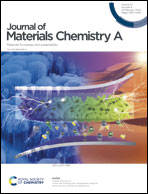Achieving high selectivity for nitrate electrochemical reduction to ammonia over MOF-supported RuxOy clusters†
Abstract
Nitrate (NO3−) electroreduction to ammonia (NH4+) is a sustainable alternative strategy for NH4+ synthesis, and it can be used to solve the water pollution problem by simultaneously turning waste into high-value ammonia. However, the conversion of NO3− into NH4+ involves multi-electron transfer reactions that could generate a series of nitrogen oxyanions and hydrogen as undesired byproducts. The design of efficient catalysts to selectively transform NO3− into NH4+ is, therefore, highly needed. In this work, we report RuxOy clusters stabilized on nickel metal–organic frameworks (RuNi-MOFs) and evaluate their electrocatalytic NO3− reduction performance. The catalyst exhibits nearly 100% NH4+ selectivity with an NH4+–N yield rate of up to 274 μg h−1 mgcat.−1 at −1.7 V vs. Ag/AgCl, and a maximal NH4+ faradaic efficiency (FE) of ∼73% at −1.2 V vs. Ag/AgCl. The theoretical calculations show that the NO2− intermediate is easily further reduced to NH4+, and could maintain nearly 100% NH4+ selectivity. This novel strategy will provide a new idea for green ammonia synthesis.



 Please wait while we load your content...
Please wait while we load your content...